
Ceratophora is a genus of agamid lizards found in Sri Lanka. The male has a horn on its snout.
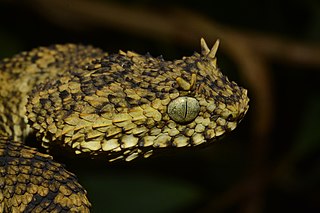
Atheris ceratophora is a venomous viper species endemic to a few mountain ranges in Tanzania. This used to be the only horned, arboreal viper known from Africa, until the discovery in 2011 of Atheris matildae, also found in Tanzania. No subspecies are currently recognized.

The rhino-horned lizard, also commonly known as Stoddart's unicorn lizard and the mountain horned agama, is a species of lizard in the family Agamidae. The species is endemic to Sri Lanka. It is called kagamuva angkatussa-කගමුව අං කටුස්සා in Sinhala.

The spineless forest lizard, crestless lizard or lionhead agama is a species of lizard in the family Agamidae. It is endemic to Sri Lanka.

Ceratophora tennentii, commonly known as the rhinoceros agama, horn-nosed lizard, and Tennent's leaf-nosed lizard, is a species of lizard in the family Agamidae. The species is endemic to Sri Lanka.

Boiga barnesii is a species of cat snake endemic to Sri Lanka. It is known as Barnes' cat snake in English and panduru mapila-පදුරු මාපිලා in Sinhala. It is a member of the snake family Colubridae. It is distributed in the lowlands and midlands up to approximately 600 m (2,000 ft) above sea level, with known localities include Matale, Kandy, Gannoruwa, Gampola, Ambagamuwa, Balangoda, Labugama and Sinharaja Rain Forest. Barnes' cat snake is mainly a forest-dwelling species but may occasionally be found in human habitats. It is the smallest cat snake in Sri Lanka and grows up to a maximum of about 600 mm (24 in) in snout-vent length. Being a nocturnal and an arboreal hunter, it mainly feeds on agamid lizards and geckos. The day time is usually spent inside a tree hole or a crevice. It’s a very timid and a mildly venomous snake and rarely attempts to bite.
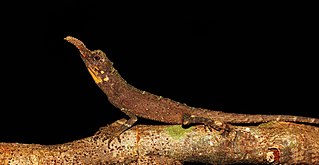
The rough-nosed horned lizard or Sri Lanka horned agama is an Agamid lizard from Sri Lanka in lowland dipterocarp forests and secondary forests in the wet zone. It is distinguished from all the other Ceratophora species by the presence of a complex rostral appendage, comprising more scales than rostral scale alone. The lateral body scales are small and more or less regular shape.

Calotes nigrilabris, the black-cheek lizard, is an agamid species endemic to Sri Lanka. It can be distinguished easily from painted-lipped lizard by having black bar on mouth rather than white or orange bar.
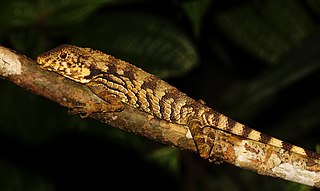
Ceratophora erdeleni, also known commonly as Erdelen's horned lizard or Erdelen's horn lizard, is a species of lizard in the family Agamidae. The species is endemic to Sri Lanka. It has only a rudimentary "horn", that is occasionally missing altogether.
Calotes desilvai, commonly known as the Morningside lizard, or the Ceylon black-band whistling lizard, is a species of lizard in the family Agamidae. Calotes desilvai is one of seven Calotes species endemic to Sri Lanka.
Calodactylodes illingworthorum is a species of gecko, a lizard in the family Gekkonidae. The species is known only from the island of Sri Lanka. Common names for C. illingworthorum include the golden gecko, Illingworths' gecko, Illingworths' golden gecko, and the Sri Lankan golden gecko.
Cnemaspis kumarasinghei, commonly known as Kumarasinghe's day gecko, is a species of lizard in the family Gekkonidae. The species is endemic to the island of Sri Lanka.
Cyrtodactylus edwardtaylori is a species of Asian bent-toed gecko, a lizard in the family Gekkonidae. The species, which is endemic to Sri Lanka, was originally described by Sri Lankan herpetologists Sudesh Batuwita and Mohomed M. Bahir in 2005.
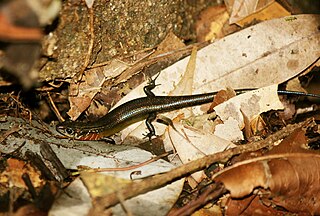
Lankascincus gansi, also commonly known as Gans's lankaskink and Gans's tree skink, is a species of lizard in the family Scincidae. The species is endemic to the island of Sri Lanka.
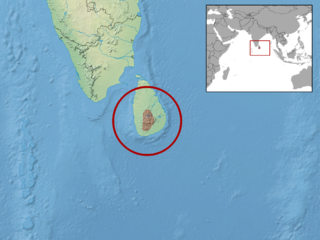
Lankascincus taprobanensis, also known commonly as the Ceylon tree skink and the smooth Lanka skink, is a species of lizard in the family Scincidae. The species is endemic to the island of Sri Lanka.
Lankascincus taylori, commonly known as Taylor's tree skink, is a species of lizard in the family Scincidae. The species is endemic to the island of Sri Lanka.
Eutropis floweri, also known commonly as Flower's skink, Taylor's skink and Taylor's striped mabuya, is a species of lizard in the family Scincidae. The species is endemic to the island of Sri Lanka. It is probably named after Stanley Smyth Flower.
Eutropis madaraszi, also known commonly as the Sri Lanka bronze mabuya, the Sri Lanka bronze skink, or (ambiguously) the spotted skink, is a species of lizard in the family Scincidae. The species is endemic to the island of Sri Lanka.
Nessia deraniyagalai, commonly known as Deraniyagala's snake skink, Deraniyagala's snakeskink, or Deraniyagala's nessia, is a species of limbless lizard in the family Scincidae. The species is endemic to the island of Sri Lanka.
Nessia didactyla, also known commonly as the two-toed nessia and the two-toed snakeskink, is a species of skink, a lizard in the subfamily Scincinae of the family Scincidae. The species is endemic to the island of Sri Lanka.











